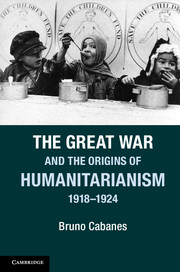Book contents
- Frontmatter
- Contents
- Acknowledgments
- Introduction Human disasters: humanitarianism and the transnational turn in the wake of World War I
- 1 “Rights, not charity”: René Cassin and war victims
- 2 Justice and peace: Albert Thomas, the International Labor Organization, and the dream of a transnational politics of social rights
- 3 The tragedy of being stateless: Fridtjof Nansen and the rights of refugees
- 4 The hungry and the sick: Herbert Hoover, the Russian famine, and the professionalization of humanitarian aid
- 5 Humanitarianism old and new: Eglantyne Jebb and children's rights
- Conclusion Human dignity: from humanitarian rights to human rights
- Further reading
- Bibliography
- Index
- References
5 - Humanitarianism old and new: Eglantyne Jebb and children's rights
Published online by Cambridge University Press: 05 June 2014
- Frontmatter
- Contents
- Acknowledgments
- Introduction Human disasters: humanitarianism and the transnational turn in the wake of World War I
- 1 “Rights, not charity”: René Cassin and war victims
- 2 Justice and peace: Albert Thomas, the International Labor Organization, and the dream of a transnational politics of social rights
- 3 The tragedy of being stateless: Fridtjof Nansen and the rights of refugees
- 4 The hungry and the sick: Herbert Hoover, the Russian famine, and the professionalization of humanitarian aid
- 5 Humanitarianism old and new: Eglantyne Jebb and children's rights
- Conclusion Human dignity: from humanitarian rights to human rights
- Further reading
- Bibliography
- Index
- References
Summary
“The soldiers are the ‘Heroes of Europe,’ but it is the thousands of sick and starving and helpless and deserted folk, whose misery is unrelieved by the sense of adventure and victory, who pay the price for war's arbitrament.”
Eglantyne Jebb, “Where war has been lady's work in Macedonia,” May 30, 1913.At the end of September 1924, the League of Nations met for its fifth General Assembly in the Salle de la Réformation, located in the very heart of Geneva. The Ministers of Foreign Affairs from twenty-one European countries had made the journey there, in addition to the British and French Prime Ministers, Ramsay MacDonald and Edouard Herriot. They had come to discuss the recently finished London Reparations Conference as well as the Dawes Plan, which had just taken effect several days earlier.
On the morning of September 26, the delegates examined a short document entitled the “World Child Welfare Charter.” It was the work of an international association founded in 1920, the Save the Children International Union (SCIU), and, more specifically, the work of a British activist, Eglantyne Jebb, then 48 years old. The preamble’s first words rang out with the promise of a new era: “Mankind owes to the Child the best that it has to give . . . beyond and above all considerations of race, nationality, or creed.”
- Type
- Chapter
- Information
- The Great War and the Origins of Humanitarianism, 1918–1924 , pp. 248 - 299Publisher: Cambridge University PressPrint publication year: 2014
References
- 2
- Cited by



